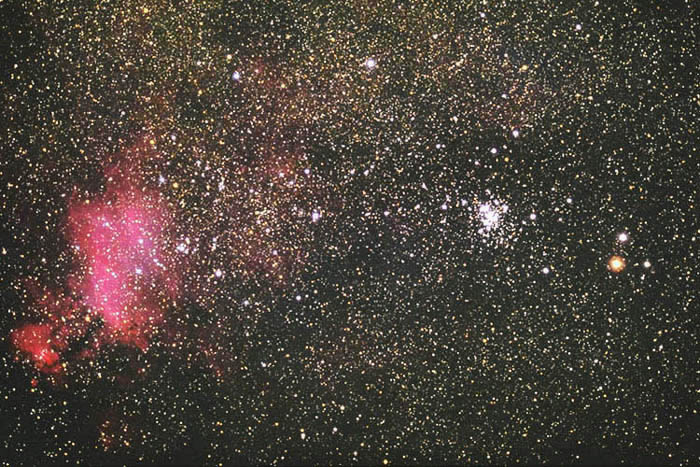All day I've been meaning to comment on this great picture - thanks for creating the image, Marco Lorenzi! - but I have been busy and tired and scatter-brained and I haven't had access to my software and....
I didn't recognize the nebula or the cluster, but the picture looks very suggestive. The very fact that there's a large emission nebula there is fascinating. Emission nebulae aren't all that common, and moderately unreddened, obvious ones are less common still. Not all young star clusters have them. For example,
the Double Cluster in Perseus, which contain large numbers of hot bright stars and are believed to be about five million years, lack any nebulosity. On the other hand,
NGC 6559 in Sagittarius, which does not contain any obvious O stars, does have a moderately bright nebular arc and a large, faint emission nebula. And just think of
NGC 7000, the North America Nebula, which seems unrelated to any of the hot blue stars that are seen "in" it or near it. There are probably various reasons for the presence or absence of emission nebulae near hot stars: the stars may have "blown away" all the gas, for example, or two gas clouds may be violently colliding for other reasons than the wind and brilliance of hot stars.
So what causes the emission nebula in this case? Is it the stars themselves, or is it some "background factor" of some sort? Maybe a past supernova explosion, although the shape of the nebula doesn't seem right for that? A moderately nearby but separate powerful cluster whose wind makes the gas collide violently with the surrounding interstellar medium?
NGC 6231 on the right and IC 4628 and Cr 316 at left.
Photo: Michael A. Stecker.
After getting access to my software, I'd say that a combination of ultraviolet light from the hot blue stars in the scattered cluster in this picture (called Collinder 316), plus the strong wind
and ultraviolet from moderately nearby, massive young open cluster NGC 6231 seems like the most probable reason for the emission nebula. That is because Collinder 316 and emission nebula IC 4628 are like extensions of NGC 6231.
APOD Robot wrote:
Nearby hot, massive stars, millions of years young, radiate the nebula with invisible ultraviolet light, stripping electrons from atoms.
This piqued my interest. How young are the stars of Collinder 316? If they are hot enough to ionize the hydrogen gas in the vicinity and create an appreciable emission nebula, then they really can't be very many million years old.
A clue may be found in the estimated age of NGC 6231, the compact nearby cluster.
It seems likely that NGC 6231 and Collinder 136 are related. In my (amateur) opinon, it seems likely that NGC 6231 came first, and Collinder 136 was created in a wave of secondary star formation. If so, Collinder 136 is younger than NGC 6231.
Take a look at Marco Lorenzi's fine APOD again. The "moderately single-looking" brightish blue star at six o'clock is an evolved star star, HD 152667, possibly similar to Alnilam in Orion's Belt, according to my software. However, the small clustering of small stars to the upper right of HD 152667 is centered on what my software describes as a star of spectral class O7. If it is really a star of spectral class O7, then it is definitely hot enough to ionize an emission nebula. What's more, the small blue star directly above HD 152667, situated in the middle of the brightest part of the nebula and possibly the chief source of ionization, HD 152723, is also described by my software as a star of spectral class O7. These two O7 stars are likely younger than 3.2 million years.
What a fine and fascinating APOD this is!
Ann
 IC 4628: The Prawn Nebula
IC 4628: The Prawn Nebula
